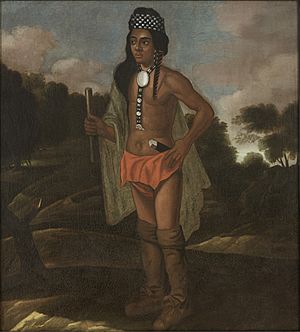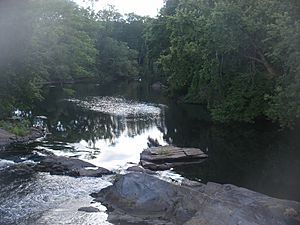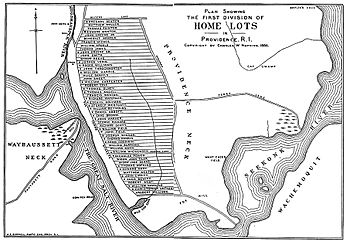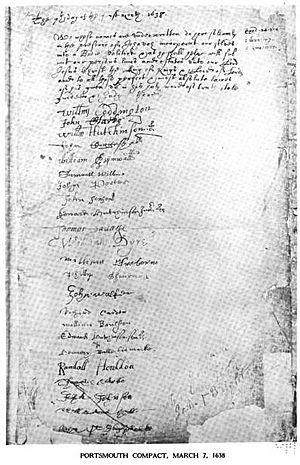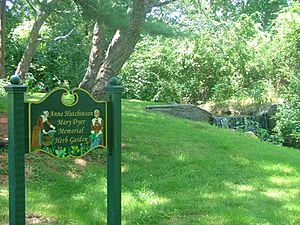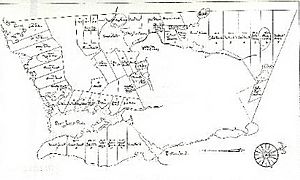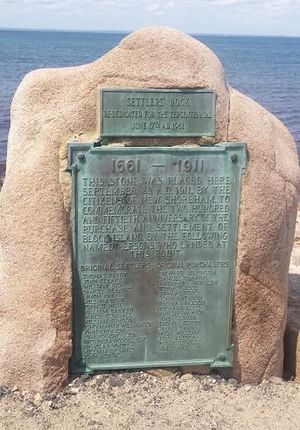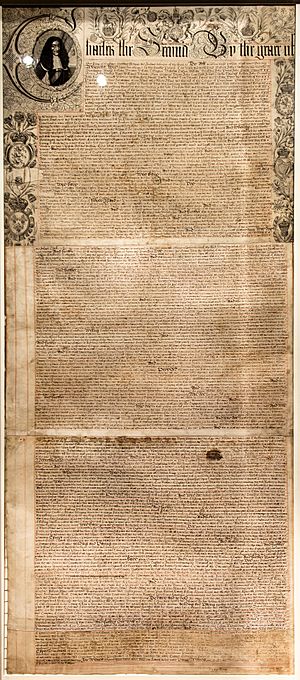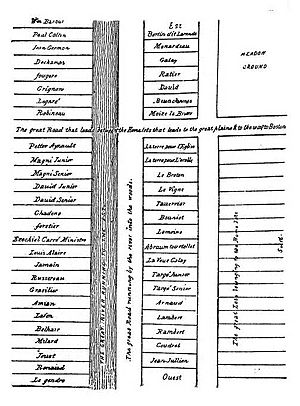List of early settlers of Rhode Island facts for kids
The Colony of Rhode Island and Providence Plantations was one of the first places in America where people could live freely and practice any religion they chose. This article shares lists of the first people who settled here before the year 1700. Most lists show the earliest residents of a specific town or area.
Contents
- Native American Tribes and Their Leaders
- First European Settlers
- The First Settlers of Providence
- Providence Civil Compact of 1637
- Original Land Owners of Providence
- Early Settlers of Pawtuxet
- Providence Agreement for a Government, 1640
- Early Settlers of Wickford
- Founders of Portsmouth
- Early Residents of Aquidneck Island (1638)
- Residents of Portsmouth After the Split with Newport
- Founders of Newport
- Founders of Warwick
- Pettaquamscutt Land Purchasers
- Early Settlers of New Shoreham (Block Island)
- People Named in the Royal Charter of 1663
- Early Residents of Westerly
- Colonial Leaders During King Philip's War
- Original Land Owners of East Greenwich
- Early Settlers of Bristol (1680)
- Settlers of Frenchtown
- Other Important Early Settlers (Before 1700)
- See also
Native American Tribes and Their Leaders
Before European settlers arrived, several Native American tribes lived in the area that became Rhode Island. They had their own leaders and ways of life.
The Wampanoag people lived in what is now Bristol, Rhode Island, and parts of Plymouth Colony.
- Massasoit: A very important tribal leader who met the Pilgrims when they first arrived.
- Wamsutta: Massasoit's son, also known as Alexander. He became a leader after his father but died soon after.
- Metacomet: Another son of Massasoit, known as Philip. He became a leader after his brother and started King Philip's War.
The Narragansett people lived all over the Rhode Island colony.
- Canonicus: A chief leader who gave land to Roger Williams. This land became the first settlement of Providence.
- Miantonomo: Canonicus's nephew. He sold land to Samuel Gorton and others, which became the town of Warwick.
- Canonchet: Miantonomo's son. He led the Narragansetts during a big battle called the Great Swamp Fight.
- Pumham: A lesser leader in Kent County, Rhode Island.
- Soconoco: Another lesser leader from the same area as Pumham.
The Niantic people lived near the Pawcatuck River in the southwestern part of Rhode Island.
- Ninigret: He wisely kept his tribe neutral during King Philip's War, meaning they didn't pick a side.
- Harman Garrett: An Indian governor and Ninigret's nephew.
The Nipmuc people often moved through the Rhode Island Colony, mostly from the north.
First European Settlers
- William Blackstone: He was the very first European to settle alone in the area. He lived along the Blackstone River in what is now Cumberland, Rhode Island, around 1634–1635. At that time, this land was part of the Plymouth Colony.
The First Settlers of Providence
Roger Williams was a minister who was asked to leave the Massachusetts Bay Colony in 1635 because of his beliefs about religious freedom. He found shelter with the Wampanoag people. He bought land from Chief Massasoit in an area called Seekonk.
In 1636, Roger Williams and a few friends planted crops in Seekonk. However, the governor of Plymouth Colony told them they were still in Plymouth's territory. He suggested they move across the Seekonk River into Narragansett land, where no colony had a claim.
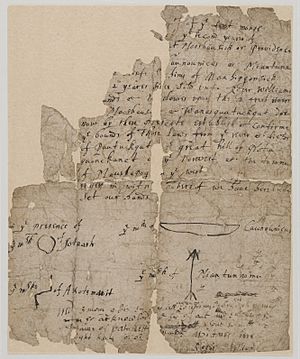
Roger Williams and his group moved and settled in what became Providence. This happened around April 1636. They bought the land from the Narragansett leaders.
Here are the people who were likely the very first settlers in Providence:
- Roger Williams (his wife Mary and daughters Mary and Freeborn came later)
- William Harris (his wife Susannah and son Andrew came later)
- John Smith (his wife Alice and children John Jr. and Elizabeth came later)
- Francis Wickes (a young person)
- Thomas Angell (a young person)
- Joshua Verin (his wife Jane may have come later)
The Arnold family also arrived around this time:
- William Arnold with his wife Christian, daughter Joanne, and sons Stephen and Benedict
- William Carpenter with his wife Elizabeth (who was William Arnold's daughter)
- William Mann with his wife Frances Hopkins (who was William Arnold's niece)
- Thomas Hopkins, a young person and nephew of William Arnold. He was an ancestor of future Governor Stephen Hopkins.
Providence Civil Compact of 1637
As more people joined the Providence settlement, some younger men wanted to have the same rights as the older settlers, like being able to vote. So, on August 20, 1637, they created an agreement called the "civil compact." This agreement stated that everyone who wanted to live in Providence would agree to follow the rules made for the good of the community.
Here are some of the people who signed this important agreement:
- Richard Scott
- William Reynolds
- John Field
- Chad Browne
- John Warner
- George Richard
- Edward Cope
- Thomas Angell (now an adult)
- Thomas Harris
- Francis Wickes (now an adult)
- Benedict Arnold (now an adult)
- Joshua Winsor
- William Wickenden
Original Land Owners of Providence
These individuals were named in a land deed from Roger Williams around October 8, 1638. They were considered the original owners of land in Providence.
- Roger Williams
- Stukeley Westcott
- William Arnold
- Thomas James
- Robert Coles
- John Greene
- John Throckmorton
- John Sweet
- William Harris
- William Carpenter
- Thomas Olney
- Francis Weston
- Richard Waterman
- Ezekiel Holyman
Early Settlers of Pawtuxet
Around 1638, some settlers left Providence to create a new settlement on the north side of the Pawtuxet River. From 1642 to 1658, this area was under the control of the Massachusetts Bay Colony.
Here are some of the Pawtuxet settlers:
- William Arnold
- Benedict Arnold (later moved to Newport in 1651)
- William Carpenter
- Thomas Hopkins
- William Mann
- Robert Coles
- William Harris
- Zachariah Rhodes
- William Field
- Stukeley Westcott (later moved to Warwick)
Providence Agreement for a Government, 1640
On July 27, 1640, 39 settlers in Providence signed an agreement to officially form a government for their town. This was an important step in organizing the colony.
Here are some of the people who signed this agreement:
- Chad Brown
- Robert Coles
- William Harris
- John Throckmorton
- Stukely Westcott
- Benedict Arnold
- William Carpenter
- Richard Scott
- Thomas Harris
- Francis Wickes
- Thomas Angell
- Adam Goodwin
- William Burrows
- Roger Williams
- Robert West
- Joshua Winsor
- Robert Williams
- Mathew Waller
- Gregory Dexter
- John Lippitt
- John Warner
- John Field
- William Arnold
- William Field
- Edward Cope
- Edward Manton
- William Man
- Nicholas Power
- William Reynolds
- Thomas Olney
- Richard Waterman
- William Wickenden
- Edward Hart
- Hugh Bewit
- Thomas Hopkins
- Joan Tiler (a widow)
- Jane Sears (a widow)
- Christopher Unthank
- William Hawkins
Early Settlers of Wickford
The area known as Wickford, which was part of the "Narragansett country" (now North Kingstown), had early trading posts. These posts were important for trading with Native Americans.
- Richard Smith: He built a trading post around 1637. His house, Smith's Castle, still stands today.
- Roger Williams: He also built a trading post about a mile north of Smith's. He used it from 1644 to 1651, then sold it to Smith to help fund a trip to England.
- Mr. Wilcox (possibly Edward or John): He built a trading post in the early 1640s in the same area.
Founders of Portsmouth
Many people who supported Anne Hutchinson signed the Portsmouth Compact on March 7, 1638. Anne Hutchinson was a religious leader who was also banished from Massachusetts Bay Colony for her beliefs. These people then founded the town of Portsmouth.
- William Coddington
- John Clarke
- William Hutchinson (Anne Hutchinson's husband)
- John Coggeshall
- William Aspinwall
- Samuel Wilbore
- John Porter
- John Sanford
- Edward Hutchinson, Jr. (Anne and William Hutchinson's oldest son)
- Thomas Savage
- William Dyer (husband of Mary Dyer)
- William Freeborn
- Philip Shearman
- John Walker
- Richard Carder
- William Baulston
- Edward Hutchinson, Sr. (William Hutchinson's brother)
- Henry Bull
- Randall Holden
Four other names were on the list but crossed out: Thomas Clarke, John Johnson, William Hall, and John Brightman. However, these men still came to Portsmouth or Newport.
Early Residents of Aquidneck Island (1638)
Aquidneck Island, later officially named Rhode Island, was settled by many people in 1638. The entire colony eventually took its name from this island. The lists below show some of the earliest residents of Pocasset (later Portsmouth) and Newport.
These people agreed to live on Aquidneck Island and follow the government established there, based on the word of God:
- Samuel Hutchinson
- Thomas Emons
- Richard Awards
- Edward Willcoks
- George Gardiner
- William Witherington
- Mr. Samuel Gorton
- John Wickes
- Ralph Earle
- Nicholas Browne
- Richard Burden [Borden]
- Richard Maxon
- Mr. Nicholas Esson
- Thomas Spicer
- Robert Potter
- William Nedham
- Sampson Shatton
- Adam Mott
- John Mott
- Mr. Robert Jefferyes
- Thomas Hitt
- James Tarr
- John Roome
- Robert Gilham
- Jeremy Clarke
- Nicholas Davis
- Wm. Baker
- John More
- Anthony Pain
- George Potter
- Wm. Richardson
- Wm. Quick
- Thomas Clarke
- John Johnson
- William Hall
- John Briggs
- James Davis
- George Parker
- Erasmus Bullock
- George Cleer
- Thomas Hazard
- William Cowlie
- Jeffery Champlin
- Richard Sarle
- John Sloff
- Thomas Beeder
- John Tripp
- Osamund Doutch
- John Marshall
- Robert Stanton
- Joseph Clarke
- Robert Carr
- George Layton
- John Arnold
- William Havens
- Thomas Layton
- Edward Poole
- Mathew Sutherland
These people were admitted as residents in the town of Newport after May 20, 1638:
- Marmaduke Ward
- Robert Field
- Thomas Stafford
- Job Tyler
- Thomas Sauorie
- Hugh Durdall
- William Baker
- John Layton
- Mr. Will Foster
- John Hall
- Tobye Knight
- John Peckum
- Michel Williamson
- Mr. Robert Lintell
- Richard Smith
- James Rogers
- John Smith
- Wm. Parker
- John Grinman
- Edward Rero
- John Macummore
- Robert Root
- Ezekiah Meritt
- James Burt
- John Bartlett
- Edward _________
- Sampson Salter
- Nicholas Cottrell
- John Vaughan
- John Smith
- John Merchant (arrived July 2)
- Jeremy Gould
- Enoch Hunt
- Nathaniel Adams
- Samuel Allen
- George Allen
- Ralph Allen
- Mr. Thomas Burton
- Henry Bishop
- John Hicks
- Edward Browce
- Mathew Gridell (arrived August 5)
Residents of Portsmouth After the Split with Newport
Some settlers left Portsmouth to found Newport. The people listed below stayed in Portsmouth and signed an agreement for their own government on April 30, 1639.
- William Hutchinson
- Samuel Gorton
- Samuel Hutchinson
- John Wickes
- Richard Magson
- Thomas Spicer
- John Roome
- John Geoffe (?)
- Thomas Beddar
- Erasmus Bullock
- Samson Shotten
- Ralphe Earle
- Robert Potter
- Nathaniel Potter
- George Potter
- William Havens
- George Shaw
- George Lawton
- Anthony Paine
- Job Hawkins
- Richard Awarde
- John Moore
- Nicholas Browne
- William Richardson
- John Tripp
- Thomas Layton
- Robert Stanton
- John Briggs
- James Davis
- William Aspinwall (did not sign but stayed)
Founders of Newport
These individuals signed an agreement to create a new government for the town of Newport on April 28, 1639.
- William Coddington
- Nicholas Easton
- John Coggeshall
- William Brenton
- John Clarke
- Jeremy Clarke (his wife was Frances (Latham) Clarke)
- Thomas Hazard
- Henry Bull
- William Dyer
Founders of Warwick
These people bought land from the Native Americans on January 12, 1642, to establish the town of Warwick.
- Randall Holden
- John Greene
- John Wickes
- Francis Weston
- Samuel Gorton
- Richard Waterman
- John Warner
- Richard Carder
- Samson Shotten
- Robert Potter
- William Wodell
- Nicholas Power
- John Sweet
Pettaquamscutt Land Purchasers
These individuals bought the Pettaquamscutt lands (which later became South Kingstown) from the Native American leaders in 1657.
Original purchasers:
- John Porter
- Samuel Wilbore
- Thomas Mumford
- Samuel Wilson
- John Hull (a goldsmith and coin maker from Boston)
Later purchasers:
In 1659, another group formed the Atherton Trading Company. They also claimed rights to land in the Narragansett area, including Wickford. However, their claim was later declared invalid.
Early Settlers of New Shoreham (Block Island)
Block Island, also known as New Shoreham, was purchased in April 1661. A plaque on the island lists the original purchasers and the first settlers.
The original purchasers of Block Island:
- Thomas Terry
- John Clarke
- William Jud
- Samuel Dearing
- Simon Ray
- William Tosh
- Tormut Rose
- William Barker
- Daniel Cumball
- William Cohoone
- Duncan Mack Williamson
- John Rathbun
- Edward Vorce, Jun.
- Trustrum Dodge, Sen.
- Nicholas White
- William Billings
- John Ackurs (Acres)
The early settlers whose names appear on the plaque:
- Richard Billingum
- Samuel Dearing
- Nathaniel Winslow
- Tormut Rose
- Edward Vorce
- John Rathbun
- Thomas Faxson
- Richard Allis
- Phillip Warton
- John Glover
- Thomas Terry
- James Sands
- Hugh Williams
- John Alcock
- Peter George
- Simon Ray
- Trustrum Dodge (also an original purchaser)
People Named in the Royal Charter of 1663
The Rhode Island Royal Charter was a very important document signed by King Charles II on July 8, 1663. This charter gave Rhode Island the right to govern itself and was the basis for its government for almost 200 years. Many early Rhode Island residents were named in this document.
- Author: John Clarke (he helped write the charter)
- Governor: Benedict Arnold
- Deputy Governor: William Brenton
Assistants (who helped the Governor):
- William Baulston
- John Porter
- Roger Williams
- Thomas Olney
- John Smith
- John Greene
- John Coggeshall
- James Barker
- William Field
- Joseph Clarke
Other important people named in the document:
- William Codington
- Nicholas Easton
- Samuel Gorton
- John Wickes
- Gregory Dexter
- Randall Holden
- John Roome
- Samuel Wildbore
- Richard Tew
- Thomas Harris
- William Dyre
- Rainsborrow (first name not given)
- Williams (likely Robert Williams, Roger Williams's brother)
- John Nickson
Early Residents of Westerly
The town of Westerly, first called Misquamicut, was bought on August 27, 1661, by men from Newport.
- William Vaughan
- John Coggeshall, Jr.
- John Crandall
- Hugh Mosher
- James Barker
- Caleb Carr
- James Rogers
- Joseph Torry
- John Cranston
Of these, only John Crandall seems to have settled in Westerly.
Here are some Westerly residents from town records dated May 18, 1669:
- John Crandall
- Edward Larkin
- Stephen Wilcox
- John Lewis
- James Cross
- Jonathan Armstrong
- John Maxson
- Jeffrey Champlin, Sr.
- John Fairfield
- Daniel Cromb
- Nicholas Cottrell
- Shubael Painter
- Tobias Saunders
- Robert Burdick
- John Randall
- John MacCoon
- John Sharp
- Daniel Stanton
- James Babcock, Sr.
- Thomas Painter
- James Babcock, Jr.
- John Babcock
- Job Babcock
- Josiah Clarke
Colonial Leaders During King Philip's War

King Philip's War (1675-1676) was a very difficult and destructive time for the colonies. The Rhode Island General Assembly, which was the government, asked for advice from 16 important citizens. They wanted their wisdom to help the colony during these hard times.
These are the people whose advice was sought:
- Benedict Arnold
- John Clarke
- James Barker
- Obadiah Holmes
- William Vaughan
- William Hiscocks
- Christopher Holder
- Phillip Shearman
- Capt. John Albro
- William Wodell
- George Lawton
- Robert Hodgson
- William Carpenter
- Gregory Dexter
- Capt. Randall Holden
- Capt. John Greene
Original Land Owners of East Greenwich
In May 1677, the General Assembly met in Newport. They gave 100-acre pieces of land in East Greenwich to 48 individuals. This was to thank them for their service during King Philip's War.
- John Spencer
- Thomas Nichols (father of Deputy Governor Jonathan Nichols)
- Clement Weaver
- Henry Brightman
- George Vaughan
- John Weaver
- Charles Macarty
- Thomas Wood
- Thomas Frye (father of Deputy Governor Thomas Frye)
- Benjamin Griffin
- Daniel Vaughan
- Thomas Dungan (son of William and Frances (Latham) Dungan)
- John Pearce
- Stephen Peckham
- John Crandall (son of John Crandall)
- Preserved Pearce
- Henry Lilly
- John Albro (son of John Albro)
- Samuel Albro (son of John Albro)
- Philip Long
- Richard Knight
- John Peckham
- Thomas Peckham
- William Clarke
- Edward Day
- Edward Richmond
- Edward Calvery
- John Heath
- Robert Havens
- John Strainge
- John Parker
- George Browne
- Richard Barnes
- Samson Ballou
- John Remington
- Jonathan Devell
- Benjamin Mowrey
- Joseph Mowrey
- William Wilbore (cousin of Samuel Wilbore)
- James Eyles Pearce
- James Batty
- Benjamin Gorton (son of Samuel Gorton)
- Henry Dyre (son of William and Mary Dyer)
- John Knowles
- Stephen Arnold (son of William Arnold and brother of Governor Benedict Arnold)
- John Sanford (son of Governor John Sanford)
- William Hawkins
- John Holden (son of Randall Holden)
Early Settlers of Bristol (1680)
Bristol started as a business venture. John Gorham was promised land if he could buy it fairly from the Native Americans. This happened on September 18, 1680, when four owners received the deed to the Mount Hope Lands.
- John Walley
- Nathaniel Byfield
- Stephen Burton
- Nathaniel Oliver (who sold his share to Nathan Hayman)
- Nathan Hayman
On August 27, 1680, twelve men signed an agreement to buy lands:
- Capt. Benjamin Church
- Doctor Isaac Waldron
- Timothy Clarke
- William Ingraham
- Nathaniel Paine
- Nathaniel Reynolds
- Christopher Saunders
- John Wilkins
- Nathaniel Williams
- Samuel Woodbury
- Nathaniel Bosworth
- Benjamin Jones
By September 1, 1681, over 60 families were present at the first town meeting. They named the area Bristol, after Bristol, England. Bristol was originally part of Massachusetts but became part of Rhode Island in 1747 after a land dispute.
Here are some of the early families in Bristol:
- Eliashib Adams
- Watching Atherton
- Joseph Baster
- John Bayley
- John Birge
- Thomas Bletsoe
- Benjamin Bosworth
- Edward Bosworth
- William Brenton
- William Brown
- James Burrill
- James Burroughs (Burrows)
- David Cary (Carey)
- John Cary (Carey)
- Samuel Cobbett
- John Corps (Cope)
- Solomon Curtis
- Zachariah Curtis
- Thomas Daggett
- Jonathan Davenport
- Robert Dutch
- Jeremiah Finney
- John Finney
- Jonathan Finney
- Joseph Ford
- Anthony Fry
- Samuel Gallop
- John Gladding
- Jabez Gorham
- Richard Hammond
- Henry Hampton
- William Hedge
- William Hoar
- Jabez Howland
- Benjamin Ingell (Ingalls)
- Joseph Jacob(s)
- Daniel Landon (Langdon)
- Thomas Lewis
- John Martin Jr.
- Nicholas Mead
- George Morye (Mowrey)
- Jeremiah Osborne
- Peter Pampelion (Papillon)
- Samuel Penfield
- John Pope
- Edmund Ranger
- Increase Robinson
- John Rogers
- John Saffin
- Joseph Sandy
- John Smith
- Richard Smith
- Widdo (Elizabeth) Southard (Southworth)
- Robert Taft
- Major Robert Thompson
- William Throope
- John Thurston
- George Waldron
- Thomas Walker
- Uzal/Uzell Wardwell
- Richard White
- John Wilson
- Hugh Woodbury
Settlers of Frenchtown
In 1687, French Protestants called Huguenots settled in what is now East Greenwich. They had to leave France because they were being persecuted for their religion. On October 12, 1686, an agreement was signed between the French settlers and the landowners.
Representing the Land Owners:
- Richard Wharton
- Elisha Hutchinson (son of Edward Hutchinson)
- John Saffin
Representing the Huguenot Settlers:
- Ezechiel Carre'
- Peter Le Breton
Those who signed the agreement: The following individuals signed the agreement, often using only their last names. These names are also found on a map of the settlement.
- William Barbret
- Paul Collin
- Jean Germon
- Dechamps
- Fougere
- Grignon
- Legare'
- Robineau
- Petter Ayrault
- Magni, Junior
- Magni, Senior
- Dauid, Junior
- Dauid, Senior
- Chadene
- foretier
- Ezechiel Carre', Ministre
- Louis Alaire
- Jamain
- Bussereau
- Le moine (Moses LeMoine, father of Colonel Peter Mawney)
- Abraum tourtellot
- La Veue Galay
- Targe', Junior
- Targe', Senior
- Grasilier
- Amian
- Lafou
- Belhair
- Milard
- Jouet
- Renaud
- Le gendre
- Bertin dit Laronde
- Menardeau
- Galay
- Ratier
- Dauid
- Beauchamps
- Moize le Brun
- Le Breton
- La Vigne
- Tauerrier
- Bouniot
- Arnaud
- Lambert
- Rambert
- Coudret
- Jean Julien
The map also shows land set aside for "La terre pour L'Eglise" (land for the church) and "La terr pour L'ecolle" (land for the school). Most of these French families later moved to Massachusetts and New York after facing problems with the English settlers. However, two families stayed on their original land:
- LeMoine (their name later changed to Money, then Mawney)
- Targe' (their name became Tourgee)
The Ayrault family moved to Newport.
Other Important Early Settlers (Before 1700)
Here are some other notable individuals who settled in Rhode Island before the year 1700:
- Jireh Bull: An early settler of Pettaquamscutt (South Kingstown).
- Thomas Cornell (settler)
- Joseph Jenckes Jr.: An early settler in Pawtucket, Warwick, and Providence.
- Stephen Northup: He built a house that is still one of the oldest in the state.
- John Steere: An early settler of Providence and Smithfield, Rhode Island.
- Pardon Tillinghast: An early pastor of the First Baptist Church in America.
- John Whipple: An early settler of Providence.
- Reverend William Vaughn: The first Baptist minister in Newport.
- Reverend Thomas Dungan: A Baptist minister in Newport.
- Captain Arthur Fenner: He helped establish Rhode Island's boundaries and was a military leader in Providence Plantations during King Philip's War.
See also


